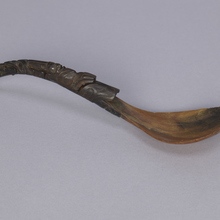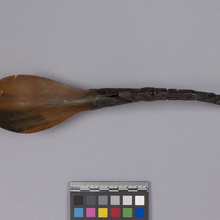Spoon
MOA: University of British Columbia
3260/42
Spoon with a carved goat horn handle attached to a translucent mountain sheep horn bowl by metal rivets. Handle carving depicts, from the tip, a human-like figure connected by an extended tongue to the raven below; at the base, a sea-bear with tail flukes, side fins, and upright ears displays a dorsal fin with human face.
-
History Of Use
Spoons were created from the horns of mountain sheep and mountain goats, for which the Haida traded with mainland peoples, as neither animal inhabits the islands of Haida Gwaii. The elaborate handles follow the natural curve of mountain-goat horn, while the bowl sections were formed by softening the horn through steaming or boiling, then cutting it, spreading it open at the base, and pressing it into a two-part wooden mold. Once the horn cooled, the final finishing and carving would begin, and the bowl was riveted to the handle. Spoons of this kind were like the “Sunday silver” of high-ranking families. Not only were they designed like totem poles in terms of the arrangement and relative scale of their figures, but the imagery similarly functioned to represent episodes of stories and the privileges of their owners.
- Type of Item spoon
- Culture Haida
- Material metal, mountain goat horn, mountain sheep horn
- Measurements height 26.5 cm, width 6.0 cm, depth 6.0 cm (overall)
- Previous Owner Elspeth McConnell
- Received from Elspeth McConnell
- Made in British Columbia
- Creation Date between 1850 and 1880
- Ownership Date before August 12, 2017
- Acquisition Date on August 12, 2017
- Condition fair
- Accession Number 3260/0042


